Written & Photographed by Kenn Sava (* unless otherwise credited)
A few weeks ago, on May 17th, Jonas Wood’s Japanese Garden 3, 2019, (i.e. a very recently completed work), sold in a benefit “to conserve one of the wettest tropical forests in the Americas” for $4,928,500.00- almost 10 times the low estimate of $500,000.00! The high estimate of $700,000. would, also, seem absurd given the past few years of Jonas Wood’s market history. My estimates would have been $1,500,000. to 2,500,000., which would put him in the price range of some of the biggest names in Art and Art history. I don’t read too much into the prices paid for Art since people buy it (like they do everything else) for any number of reasons (and it was for the benefit of a good cause). Still, the price realized for Japanese Garden 3 is remarkable when one considers that Jonas Wood’s first one man gallery shows were at the Shane Campbell Gallery, Chicago, and at Anton Kern Gallery, here, in 2007.
Already, Jonas Wood’s work is nothing less than a popular phenomenon in the world of Contemporary Painting. While I can understand his work being popular, how popular it is surprises me very much. I began to wonder what I’m missing.
And so, I have gone to each of Jonas Wood’s NYC shows since 2016 to see more and to gain a better understanding.
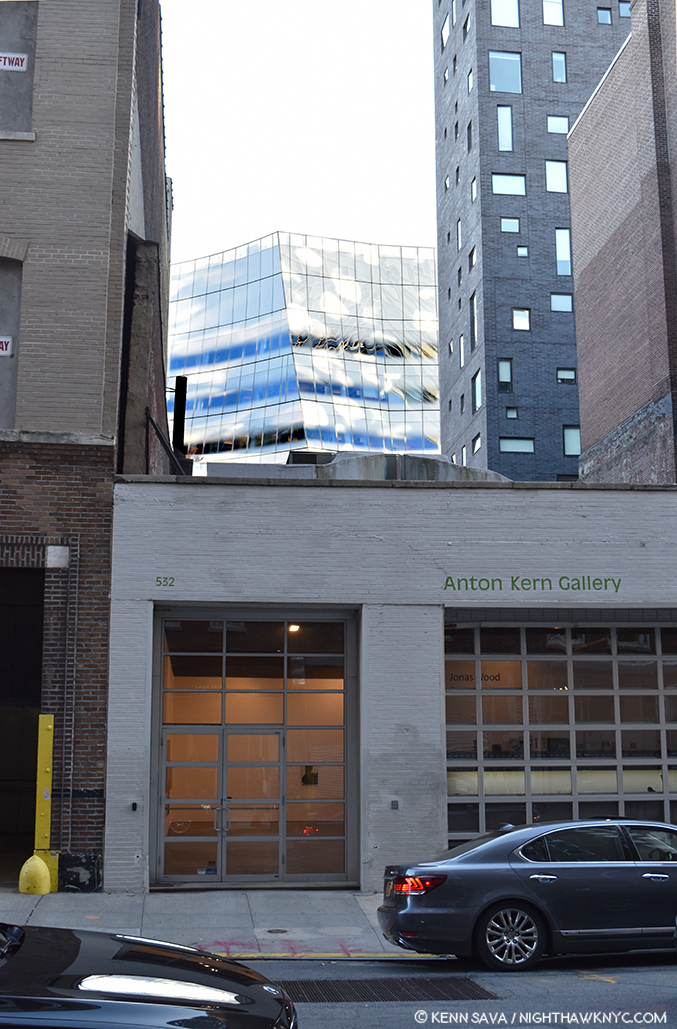
Anton Kern Gallery’s former West 20th Street, Chelsea location seen on October, 2016, during the run of Jonas Wood Portraits, with Frank Gehry’s gorgeous ICP Building looming in the back. The former Kern Gallery building has since been demolished, this view lost.
Jonas Wood first came to public attention, and may be still most renowned for his “Sports” series, a selection of which was collected in his first monograph, the extremely popular Sports Book in 2009 (See BookMarks following the piece for my List of Jonas Wood monographs & catalogues). In it, he gave us his version of sports cards and created portraits of athletes and venues, mining one of the world’s most popular subjects, which, surprisingly, very few Artists have, Raymond Pettibon being to my eye, the most compelling. Born in Boston, Mr. Wood features a number of Celtics and Boston Garden, though his selection ranges from the famous (Shaquille O’Neal and Yao Ming) to names only die-hard fans have even heard of, let alone are familiar with (Buddy Solomon…? Sherman Corbett?). His inclusion of the unfamiliar reminds me of Mr. Pettibon’s subjects.
To this day, a basketball doodle often accompanies Mr. Wood’s signature on books and posters as something of a personal trademark. Sports as a subject may have been the “hook” that got the attention of the Art loving public beyond those who saw his gallery shows, but his work covers a variety of subjects, with an emphasis on domestic scenes and portraits.
After solo shows at Anton Kern in 2008, 2011, and 2013 (and elsewhere in the US and Europe) followed that first 2007 show, Portraits, opened in September, 2016. By then, the buzz around Jonas Wood, and the show, was substantial.
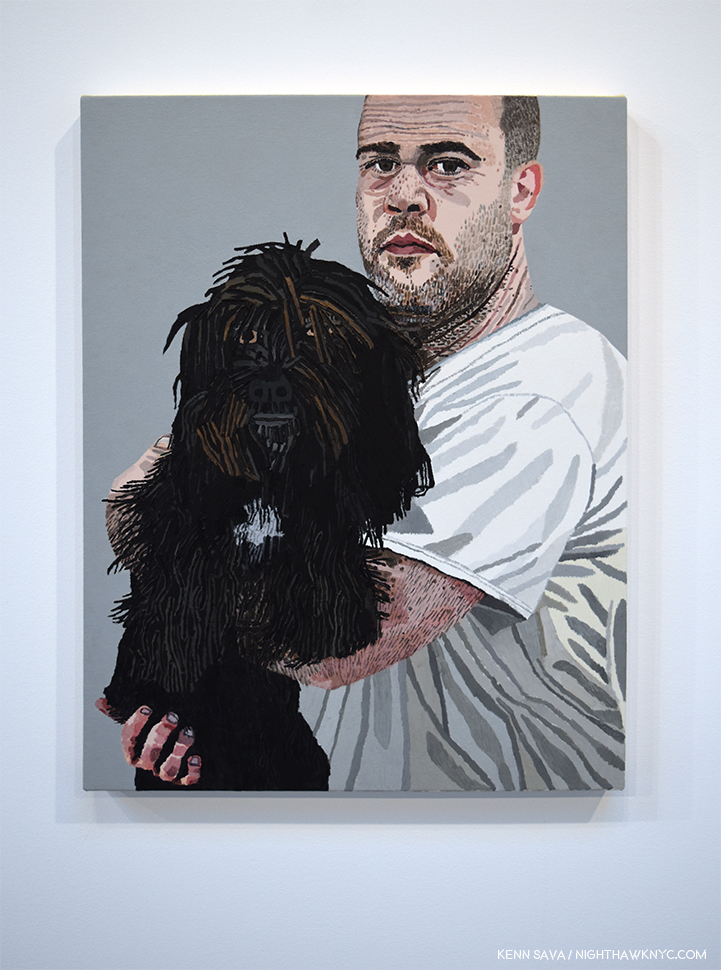
Robot (Self Portrait), 2013/16, Oil and acrylic on linen, 29 x 22 inches, seen at Portraits in 2016.
On October 19, 2016, I went to see what it was all about. I found a Painter who’s work seemed was not shy in revealing its influences (Alex Katz, David Hockney, Picasso, Matisse), in Paintings with a homey feel- these were works that were as much about place, possibly his home, as portraits of people.
They had a decidedly personal and intimate feel to them. They were “portraits” of a lifestyle. Perhaps, that’s what resonates most with his fans. (Perhaps the same can be said of Alex Katz’s and David Hockney’s work as well.)
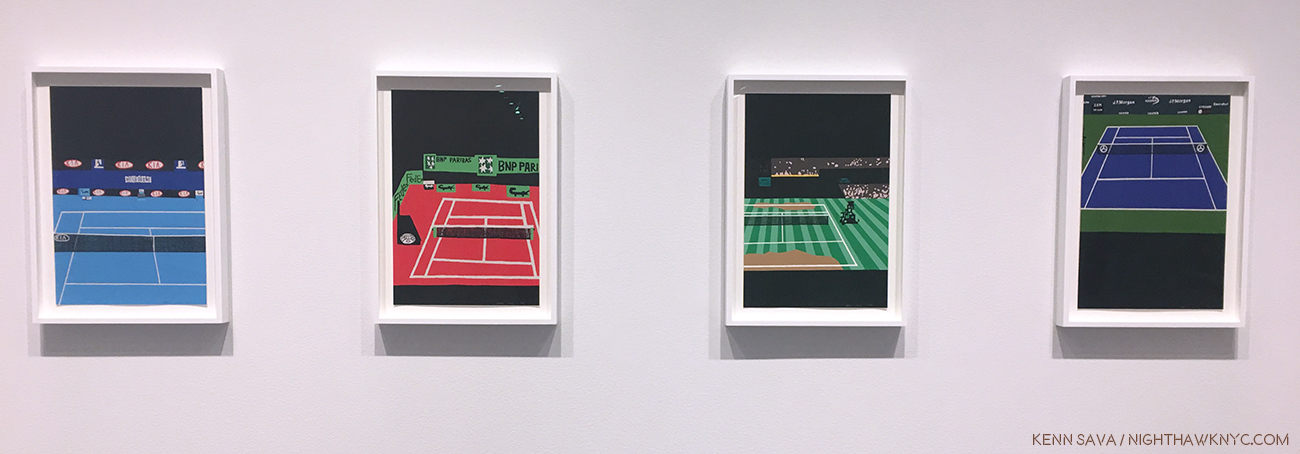
The series Four Majors, 2018, Multicolor screen print on Coventry rag paper, each 19 x 13 inches, seen at Prints in 2018.
From there, the buzz around Jonas Wood has only continued to increase. On April 19, 2018, I saw his Prints show at Gagosian, who has continued to represent the Artist.
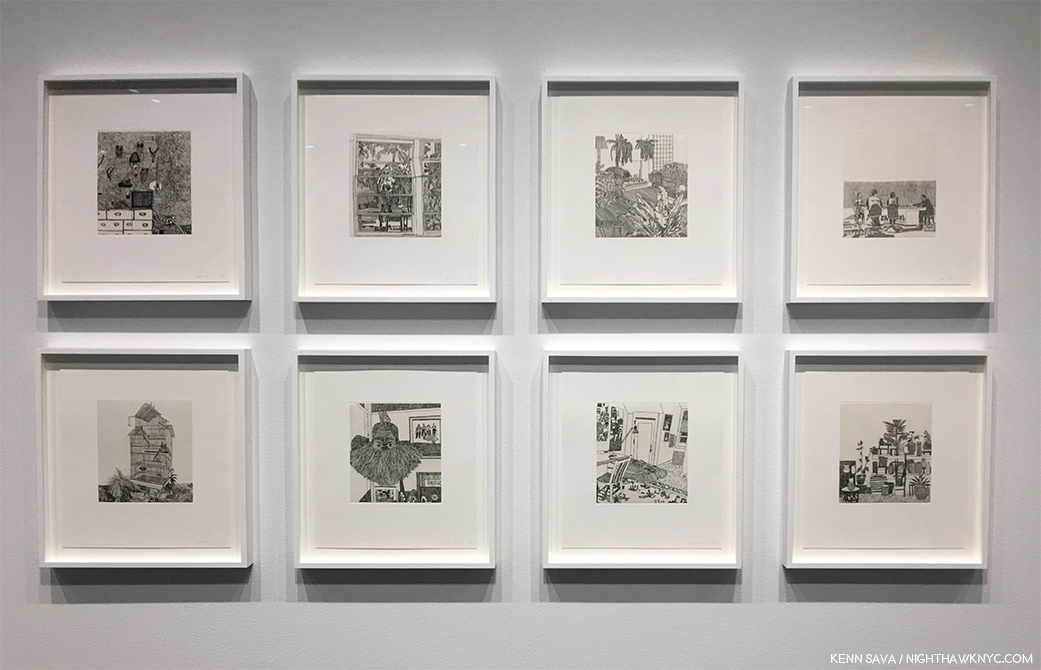
8 Etchings, 2014, Ink on Japanese paper, each 16 x 14 inches, seen at Prints. One set, of the edition of 10, is in the collection of MoMA, who own 3 Drawings but no Jonas Wood Paintings. The Whitney owns two Paintings and two Drawings. The Met owns none of his work. Sseen at Prints in 2018.
Determined to get a better understanding on what is happening here, on April 24, 2019, I went to the opening of Jonas Wood, his current show at Gagosian, West 24th Street, since I rarely go to openings, primarily to see who his fans are and what I could learn from seeing how they interacted with his Art. I missed some of the “interaction.” Each and every work on view was sold before the show opened.
Jonas Wood was on hand, followed at every turn by a film crew.
A few days later, at the opening of Gagosian’s Jeff Wall show, I met and spoke with Mr. Wood about Drawing in his practice. And, I watched with fascination over multiple visits while others stood and pondered the work wondering, “What is it about Jonas Wood that everything he touches sells, and sells for BIG prices these days-even signed books and posters?”
My guess is that there’s a peace and a quiet in his work that looks good on the walls of his buyers. These days, with so much contention, stress, upheaval and ugliness in the world, Art that reflects peace, calm, beauty, color, harmony and exudes a sense of home, contentment and even happiness, would certainly find a big audience. His work reflects, apparently, his life, interests and people he knows- as legions of Painters have been doing for centuries. The vast majority of them never found buyers for their work.
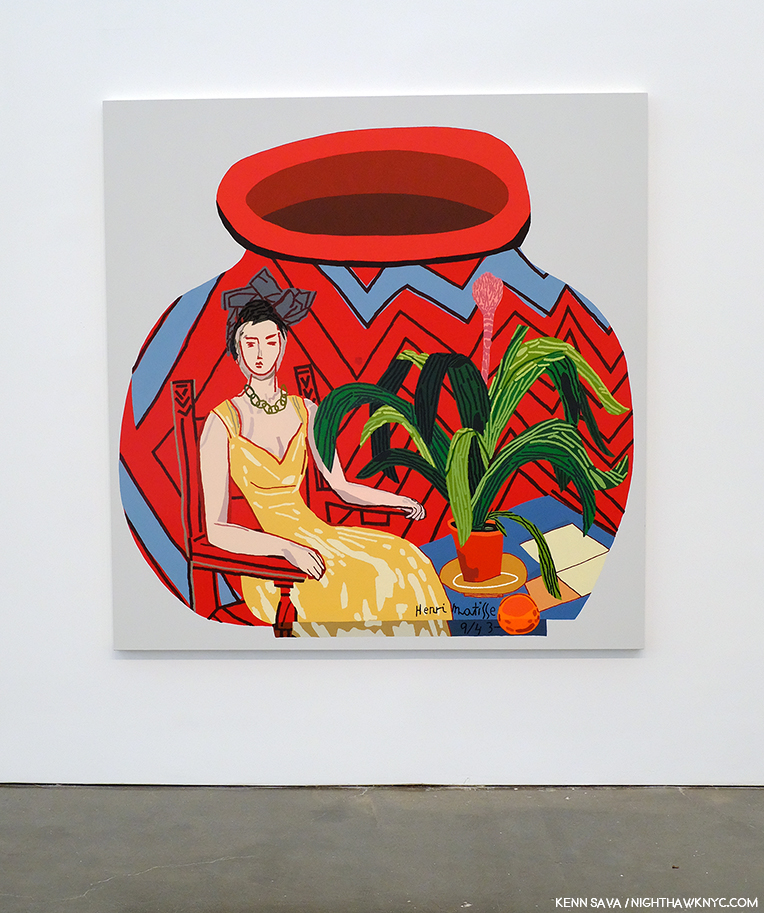
Red Portrait Pot, 2015, 76 x 74, complete with faux Matisse signature en homage. Pots have been a recurring subject in Jonas Wood’s work. His wife, Shio Kusaka, is a porcelain Artist, who he has collaborated with.
While Jonas Wood’s work bears the influences of David Hockney as well as Alex Katz, as I mentioned, but perhaps no other Artist is more to be seen in it than Henri Matisse.
Yet, once you look past them, he has developed his own style. His work featured views with unexpected planes (seemingly more often in his earlier work than in the new) that makes it both quirky and fresh. I can’t quite put my finger on a predecessor for this, though Cubism, Stuart Davis and (the incredibly overlooked) Ralston Crawford come to mind.
He loves to play with perspective- removing shadow or any sense of depth, and will add layers that jar the viewer into looking closer to try and understand what’s really being shown (as in the almost Richard Estes-like Ovitz’ Library, 2013).
Closer looking also reveals how much work goes into many of these works, many of which feature an almost obsessive amount of detail, as do their size. Finally, it is his choice of subjects that branches his work out from that of Alex Katz. Even David Hockney, who shares Jonas Wood’s love of color and domesticity hasn’t shown us the scenes Mr. Wood chooses, some of which feel like “interior still lifes.” It’s a bit miraculous, I think, that Jonas Wood has been able to balance so many influences so well and managed to produce work that is instantly recognizable as his own.
In fact, that it does so so well makes it susceptible to being ripped off by advertisers and corporations, and I expect we will see it all over soon- if we’re not already.
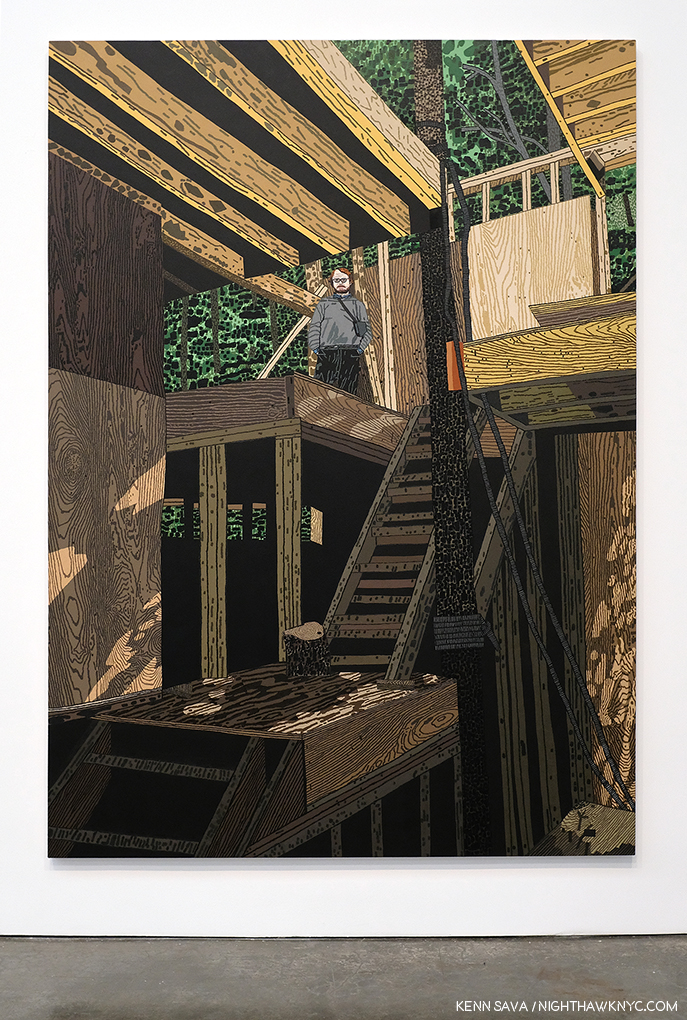
On top of the (Art) world. Young Architect, 2019, 110 x 78 inches, seen in his current show, in a room “dedicated to a series of new paintings of architectural interiors and exteriors,” to quote the press release, that includes the next work as well.
Yet, the big question, at least in my mind, remains- What does it all “mean?”
Jonas Wood’s Paintings often play with the existence of space. In some works, there is no perspective- everything is squashed right up against the picture plane (as in Japanese Garden 3), which, frankly, sometimes I find oppressive. In other pieces, there is perspective, but no shadows. This gives those pieces a surreal look. Most interestingly in his current show is Jersey City Apartment, 2019, Oil and acrylic on canvas, 104 x 142 inches, the work selected for the show’s poster. In it we see both perspective and shadows, yet no life, beyond plant life, in spite of the Art on the wall proclaiming “LIFE NEW LIFE” with the Sun over it. The apartment depicted empty, as is the landscape beyond the huge picture window (minus the Sun). On the impossibly balanced coffee table, with dual glass tops, rest seven globular “heads” with varying strange faces and expressions. The work depicts what I imagine to be the setting for a good many of Jonas Wood’s Paintings in the homes of their owners. It’s an interesting work when one considers that almost every other Jonas Wood landscape I’ve seen (partial landscape, here) takes place, apparently, in California. Perhaps? It shows the “life” of Art in the space where it has come to “live” when, possibly, its owners/residents are out working to pay the rent, the mortgage, or? The Art bill. Or, perhaps it’s a commentary of what passes for “life” today- a lonely space in the sky surrounded by steel, concrete and glass. Whatever it is, the Art in this space- the Painting, the sculptural objects on the coffee table, and the table itself, are stuck in this space, like the plants are. Together, they provide the only sign of “life” gong on here.
The show’s third gallery is full of “corresponding small-scale works on paper,” the press release informs us, one of each work shown in the rest of the show. Jersey City Apartment, for one, is fascinating to compare with the large Painting. In the small work, among other very slight differences, Jonas Wood has included an imitation Roy Lichtenstein portrait of a blonde on the column on the left, which is not included in the large work. Why not? It calls to mind what Richard Estes and Edward Hopper, among others, have said about the inclusion of people in a scene automatically drawing the viewer’s attention to them seeking a narrative reading.
In one sense, Jonas Wood is doing what Andy Warhol and the other so-called “Pop” Artists did- turning the everyday, the things that are parts of Art viewer’s every day lives, into Fine Art. He did this with sports, and he’s continued to do this, expanding into depicting a home life that, apparently, many viewers can relate to, it seems to me, in the process, elevating it to the status of “Fine Art,” as Andy Warhol, et al, did with soup cans, soap pad boxes and celebrities. And so? His is a different kind of “pop” Art. It’s Art based on what’s a part of the (equally familiar) everyday lives of his viewers. Of course, many other Artists do this. With his technique that has a rough, unfinished edge to it, bright colors, and a focus on the essential he picked up from Alex Katz, David Hockney and especially Mattisse, Jonas Wood struck a nerve. To the point that I now believe his work is here to stay. I’m not sure his market is going to stay at the 5 million dollar level (maybe he’ll surprise me), but I don’t see his popularity ending any time soon.
All of that said, how do I feel about the Art of Jonas Wood? It doesn’t speak to me, though I will keep looking. However, I am thrilled to see the work of a Painter being as popular as Jonas Wood’s is in this age of Photography and digital media seemingly taking over the world of Art. I can live with it. And maybe that’s why people buy everything the man Paints- as soon as he does. They can live with it.
BookMarks-
Jonas Wood- A List of Monographs and Catalogues
Jonas Wood’s books are, also, something of a phenomenon. They remind me of PhotoBooks in some ways- many are focused (sorry) on a specific body of work, they are highly collectible and eagerly sought after on the primary and secondary markets. A few are out of print and most are printed in relatively small numbers given his popularity today. So? It’s hard to calculate the impact they’ve had on the Jonas Wood phenomenon- a good many of those interested in Jonas Wood’s Art may have trouble finding some of these at reasonable prices. Most of these books have 48 pages, succinctly covering the title topic in a thin size, but the only book that could be considered an “overview” to date is one of the most recent- the catalog accompanying his retrospective at the Dallas Museum of Art, which is still “only” 108 pages and only includes 33 works. Into this void will step the ever interpret publishers Phaidon, who will release the first full length volume on Jonas Wood as part of their fine Contemporary Artists Series around Halloween.
Here is an overview of the monographs released thus far, listed chronologically from the date of the first edition. Title, followed by year of publication, followed by publisher, followed by information on subsequent editions. If you know of any details I’ve omitted, please let me know.
Sports Book, 2009, published by PictureBox, 2nd Edition- 2016, published by Anton Kern and David Kordansky Galleries.
New Plants Los Angeles, 2010, Anton Kern, published for his first one man museums show at the Hammer Museum
A History of the Met: Vol 1, 2010, Paper Chase Press. 2nd Edition- 2013, Jonas Wood and Anton Kern. In speaking with Mr. Wood, he indicated to me there will be a Volume 2.
Pots, 2015, Gagosian
Paintings and Drawings, 2015, David Kordansky
Portraits, 2016, Anton Kern and David Kordansky
Interiors, 2012, PictureBox, 2nd Edition- 2016, Anton Kern and David Kordansky
Paintings & Drawings, 2015, David Kordansky (Out of print)
Blackwelder (with Shio Kusaka), 2015, published by Rizzoli and Gagosian. First edition printed by The Avery Group at Shapco Printing, Minneapolis, 2nd Edition- 2017, printed by C&C Offset Printing Co, Ltd, China
Clippings, 2017, Karma (Out of print)
Prints, 2018, Rizzoli and Gagosian
Jonas Wood, 2019, Gagosian Exhibition Catalog for the current show
Shio Kusaka & Jonas Wood, 1st Edition- date & details unknown, 2019, 2nd Edition published by Stichting Voorlinden & Gagosian
Jonas Wood, 2019, Dallas Museum of Art (the catalog accompanying his first museum retrospective)
Prices on all of these range from $40. to about 150.00, with first editions of Sports Book and A History of the Met costing more- unsigned. Of these, I find Portraits and Interiors the two I turn to most. There is a little overlap between them, and the 2nd edition of Interiors seems to suffer from being reproduced. For those looking for an introduction to Jonas Wood, I would recommend they start there, at least until the Phaidon book comes out. Of course, sports fans may find the Sports Book the most interesting. However, it can be a bit harder to find, and more expensive, than the others.
NighthawkNYC.com has been entirely self-funded and ad-free for over 6 years, during which over 250 full length pieces have been published. If you’ve found it worthwhile, you can donate to keep it going & ad-free below. Thank you!
Written & photographed by Kenn Sava for nighthawknyc.com unless otherwise credited.
To send comments, thoughts, feedback or propositions click here.
Click the white box on the upper right for the archives or to search them.
For “short takes” and additional pictures, follow @nighthawk_nyc on Instagram.
Subscribe to be notified of new Posts below. Your information will be used for no other purpose.















